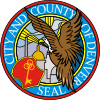Colorado State Capitol
Colorado State Capitol | |
 The Colorado State Capitol in Denver | |
| Location | 200 East Colfax Avenue Denver, Colorado, U.S. |
|---|---|
| Coordinates | 39°44′21″N 104°59′05″W / 39.7392°N 104.9848°W |
| Built | 1894 |
| Architect | Elijah E. Myers |
| Architectural style | neoclassical style |
| Part of | Denver Civic Center (ID12001017) |
| Significant dates | |
| Added to NRHP | October 16, 2012 |
| Designated CP | February 27, 1974 |


The Colorado State Capitol Building, located at 200 East Colfax Avenue in Denver, Colorado, is the home of the Colorado General Assembly and the offices of the Governor of Colorado and Lieutenant Governor of Colorado. The building is intentionally reminiscent of the United States Capitol. Designed by Elijah E. Myers, it was constructed in the 1890s from Colorado white granite, and opened for use in November 1894. The distinctive gold dome consists of real gold leaf, first added in 1908, commemorating the Colorado Gold Rush. The building is part of Denver's Civic Center area. It was listed on the National Register of Historic Places as part of the Civic Center Historic District in 1974,[2] and became part of the Denver Civic Center National Historic Landmark District in 2012.[3]
Serving as the beginning of the Capitol Hill district, the historic building sits slightly higher than the rest of downtown Denver. The main entrance hall is open 180 feet (55 m) to the top of the dome, about the height of an 18-story building. Additionally, the official elevation of Denver is measured outside the west entrance to the building, where the fifteenth step is engraved with the words "One Mile Above Sea Level." From this step, at 5,280 feet (1,609 m), the sun can be seen setting behind the Rocky Mountains. A second mile high marker was set in the 18th step in 1969 when Colorado State University students resurveyed the elevation. In 2003, a more accurate measurement was made with modern means, and the 3rd step was identified as being one mile (1.6 km) high, where a 3rd marker was installed.[4]
The interior of the building uses copious amounts of Colorado Rose Onyx, a rare rose marble from a quarry near Beulah, Colorado. The amount used in the building consumed the entire known supply. White Yule Marble from the quarries near Marble, Colorado was also used throughout the capitol for the floors. Many designs have been found in the marble including an image resembling George Washington and another of Molly Brown.[5]
A major safety upgrade project, funded by the Colorado State Historical Fund, was started in 2001 and completed in 2009.[6] The design by Fentress Architects added modern safety features, like enclosed stair towers, that blend in with the original architecture.[7]
Many of the windows are stained glass, depicting people or events related to the history of Colorado. The halls are decorated with portraits of every president of the United States. One of the contractors for the construction of the Colorado State Capitol building was Illinois building contractor William Douglas Richardson, who was the president of the W. D. Richardson Construction Company.[8] Richardson had participated in numerous major building contracts throughout the United States, and was interconnected with the Jacob Bunn and John Whitfield Bunn network of corporations.[9]
Gallery
-
Colorado State Capitol (back view)
-
Old Colorado Supreme Court chambers
-
Rotunda interior
-
Rotunda interior direct view
-
Gallery of Presidents
-
Aerial view
-
Dome exterior, closeup
-
Front steps indicating "One Mile Above Sea Level"
-
Stained glass window of Denver educator Emily Griffith
-
Capitol Interior from the third floor
-
12-pdr Napoleon cannon at the State Capitol
-
Capitol Dome close up view
-
Capitol looking up stairs from Lincoln Street
-
Statue in front of the Capitol
See also
References
- ^ "Closing Era statue". Public Art Around the World. Retrieved March 27, 2010.
- ^ Barbara Norgren; Cynthia Emrick (December 10, 1973). "National Register of Historic Places Inventory - Nomination Form: Civic Center" (PDF). National Park Service. Retrieved 2015-02-06.
- ^ "Weekly list of actions taken on properties: 10/22/12 through 10/27/12". National Park Service. November 2, 2012. Retrieved February 6, 2015.
- ^ "Mile High Marker". 2004. Retrieved Aug 27, 2013.
- ^ http://www.Colorado.gov/dpa/doit/archives/cap/marble.htm
- ^ History Colorado. Coloradohistory-oahp.org. Retrieved on 2013-09-18.
- ^ Fentress completes work on Capitol’s safety project - Denver Business Journal. Bizjournals.com (2009-02-01). Retrieved on 2013-09-18.
- ^ http://www.colorado.gov/dpa/doit/archives/cap/gold.htm
- ^ William Douglas Richardson was the father of Jacob Bunn's daughter-in-law.
External links
- Government of Colorado
- State capitols in the United States
- Domes
- National Register of Historic Places in Denver
- Visitor attractions in Denver
- Museums in Denver
- Government buildings in Colorado
- Government buildings on the National Register of Historic Places in Colorado
- Historic district contributing properties in Colorado














